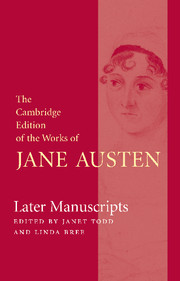General Editor’s Preface
Published online by Cambridge University Press: 18 December 2020
Summary
Jane Austen wrote to be read and reread. ‘[A]n artist cannot do anything slovenly,’ she remarked to her sister Cassandra. Her subtle, crafted novels repay close and repeated attention to vocabulary, syntax and punctuation as much as to irony and allusion; yet the reader can take immediate and intense delight in their plots and characters. As a result Austen has a unique status among early English novelists – appreciated by the academy and the general public alike.What Henry Crawford remarks about Shakespeare in Mansfield Park has become equally true of its author: she ‘is a part of an Englishman's constitution. [Her] thoughts and beauties are so spread abroad that one touches them every where, one is intimate with [her] by instinct.’ This edition of the complete oeuvre of the published novels and manuscript works is testament to Austen's exceptional cultural and literary position. As well as attempting to establish an accurate and authoritative text, it provides a full contextual placing of the novels.
The editing of any canonical writer is a practice which has been guided by many conflicting ideologies. In the early twentieth century, editors, often working alone, largely agreed that they were producing definitive editions, although they used eclectic methods and often revised the text at will. Later in the century, fidelity to the author's creative intentions was paramount, and the emphasis switched to devising an edition that would as far as possible represent the final authorial wishes. By the 1980s, however, the pursuit of the single perfected text had given way to the recording of multiple intentions of equal interest. Authors were seen to have changed, revised or recanted, or indeed to have directed various versions of their work towards different audiences. Consequently all states had validity and the text became a process rather than a fixed entity.With this approach came emphasis on the print culture in which the text appeared as well as on the social implications of authorship. Rather than being stages in the evolution of a single work, the various versions existed in their own right, all having something to tell.
The Cambridge edition describes fully Austen's early publishing history and provides details of composition, publication and publishers as well as printers and compositors where known.
- Type
- Chapter
- Information
- Later Manuscripts , pp. xi - xivPublisher: Cambridge University PressPrint publication year: 2008



